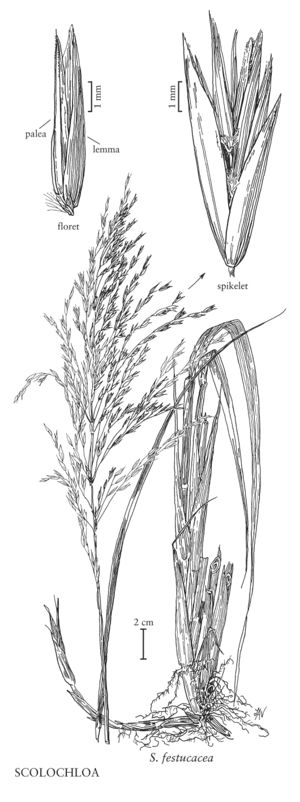Difference between revisions of "Scolochloa festucacea"
FNA>Volume Importer |
imported>Volume Importer |
||
| (3 intermediate revisions by 2 users not shown) | |||
| Line 43: | Line 43: | ||
|publication year= | |publication year= | ||
|special status= | |special status= | ||
| − | |source xml=https:// | + | |source xml=https://bitbucket.org/aafc-mbb/fna-data-curation/src/200273ad09963decb8fc72550212de541d86569d/coarse_grained_fna_xml/V24/V24_1038.xml |
|subfamily=Poaceae subfam. Pooideae | |subfamily=Poaceae subfam. Pooideae | ||
|tribe=Poaceae tribe Poeae | |tribe=Poaceae tribe Poeae | ||
Latest revision as of 16:21, 11 May 2021
Culms 70-200 cm tall, 6-8 mm thick at the base. Ligules 3-7(9) mm; blades 20-45 cm long, 4-12 mm wide. Panicles 15-30 cm; primary branches ascending to divergent, with spikelets appressed to the branches. Spikelets 7-11 mm. Lower glumes 5-8 mm; upper glumes 6.5-10 mm; calluses about 0.5 mm; lemmas 4-9 mm; paleas about as long as the lemmas; anthers 2-4 mm. 2n = 28.
Distribution
Mont., Wyo., Alaska, Minn., Oreg., Kans., Iowa, Alta., B.C., Man., N.W.T., Sask., Yukon, Idaho, N.Dak., Nebr., S.Dak.
Discussion
Scolochloa festucacea grows in ponds, marshes, seasonally flooded basins, and the shallow margins of freshwater to moderately saline lakes and streams. It provides good nesting cover for some waterfowl and shorebirds, and can provide valuable forage for livestock and wildlife. It does not compete well with hybrid cattails (Typba latifolia x T. angustifolia or T. domingensis).
Selected References
None.
